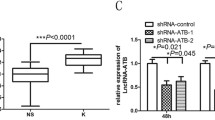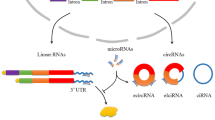Abstract
Circular RNAs (circRNAs) are implicated in keloidogenesis and development. We aimed to investigate the role of a new identified phosphodiesterase 7B-derived circRNA (hsa_circ_0002198; henceforth named as PDE7B) in human keloid fibroblasts (HKFs) and to further confirm its mechanism via competing endogenous RNA (ceRNA) network. Transcriptional and translational levels of circPDE7B, microRNA (miR)-661, fibroblast growth factor 2 (FGF2), cleaved caspase3, B-cell lymphoma (bcl)-2, and bcl-2-associated X protein (bax) were detected by real-time quantitative PCR and western blotting. Relationship among circPDE7B, miR-661, and FGF2 was confirmed by bioinformatics algorithm, dual-luciferase reporter assay, RNA immunoprecipitation, RNA pull-down assay, and Spearman’s rank correlation analysis. Cell progression was measured by cell counting kit-8 assay, 5-ethynyl-2-deoxyuridine assay, transwell assays, and flow cytometry. Expression of circPDE7B was upregulated in human keloid tissues and HKFs, accompanied with miR-661 downregulation and FGF2 upregulation. High circPDE7B accelerated proliferation, migration, and invasion, and inhibited apoptosis. These effects were paralleled with increased bcl-2 and decreased cleaved caspase3 and bax. Moreover, low circPDE7B played opposite effects to high circPDE7B. Restoring miR-661 could suppress HKFs progression, while blocking miR-661 could facilitate that. Notably, miR-661 was directly sponged by circPDE7B and then directly governed FGF2 gene expression. Deleting miR-661 and re-expressing FGF2 both abrogated the suppression of circPDE7B knockdown in HKFs progression. In conclusion, circPDE7B might contribute to HKFs progression via functioning as ceRNA for miR-661, suggesting a novel circPDE7B/miR-661/FGF2 pathway underlying keloid formation and treatment.







Similar content being viewed by others
Data availability
The analyzed data sets generated during the present study are available from the corresponding author on reasonable request.
References
Trace AP, Enos CW, Mantel A, Harvey VM (2016) Keloids and hypertrophic scars: a spectrum of clinical challenges. Am J Clin Dermatol 17:201–223. https://doi.org/10.1007/s40257-016-0175-7
Limandjaja GC, Niessen FB, Scheper RJ, Gibbs S (2020) The keloid disorder: heterogeneity, histopathology, mechanisms and models. Front Cell Dev Biol 8:360. https://doi.org/10.3389/fcell.2020.00360
He Y, Deng Z, Alghamdi M, Lu L, Fear MW, He L (2017) From genetics to epigenetics: new insights into keloid scarring. Cell Prolif. https://doi.org/10.1111/cpr.12326
Marneros AG, Krieg T (2004) Keloids–clinical diagnosis, pathogenesis, and treatment options. J Dtsch Dermatol Ges 2:905–913. https://doi.org/10.1046/j.1439-0353.2004.04077.x
Luo S, Benathan M, Raffoul W, Panizzon RG, Egloff DV (2001) Abnormal balance between proliferation and apoptotic cell death in fibroblasts derived from keloid lesions. Plast Reconstr Surg 107:87–96. https://doi.org/10.1097/00006534-200101000-00014
Andrews JP, Marttala J, Macarak E, Rosenbloom J, Uitto J (2016) Keloids: the paradigm of skin fibrosis—pathomechanisms and treatment. Matrix Biol 51:37–46. https://doi.org/10.1016/j.matbio.2016.01.013
Ogawa R (2017) Keloid and hypertrophic scars are the result of chronic inflammation in the reticular dermis. Int J Mol Sci. https://doi.org/10.3390/ijms18030606
McGinty S, Siddiqui WJ (2020) Keloid. StatPearls, Treasure Island
Lv W, Ren Y, Hou K, Hu W, Yi Y, Xiong M, Wu M, Wu Y, Zhang Q (2020) Epigenetic modification mechanisms involved in keloid: current status and prospect. Clin Epigenetics 12:183. https://doi.org/10.1186/s13148-020-00981-8
Shi J, Yao S, Chen P, Yang Y, Qian M, Han Y, Wang N, Zhao Y, He Y, Lyu L, Lu D (2020) The integrative regulatory network of circRNA and microRNA in keloid scarring. Mol Biol Rep 47:201–209. https://doi.org/10.1007/s11033-019-05120-y
Wang J, Wu H, Xiao Z, Dong X (2019) Expression profiles of lncRNAs and circRNAs in keloid. Plast Reconstr Surg Glob Open 7:e2265. https://doi.org/10.1097/GOX.0000000000002265
Zhang Z, Yu K, Liu O, Xiong Y, Yang X, Wang S, Zhang S, Feng Y, Peng Y (2020) Expression profile and bioinformatics analyses of circular RNAs in keloid and normal dermal fibroblasts. Exp Cell Res 388:111799. https://doi.org/10.1016/j.yexcr.2019.111799
Yang D, Li M, Du N (2020) Effects of the circ_101238/miR-138-5p/CDK6 axis on proliferation and apoptosis keloid fibroblasts. Exp Ther Med 20:1995–2002. https://doi.org/10.3892/etm.2020.8917
Szczypka M (2020) Role of phosphodiesterase 7 (PDE7) in T cell activity. Effects of selective PDE7 inhibitors and dual PDE4/7 inhibitors on T cell functions. Int J Mol Sci. https://doi.org/10.3390/ijms21176118
Hayashi T, Nishihira J, Koyama Y, Sasaki S, Yamamoto Y (2006) Decreased prostaglandin E2 production by inflammatory cytokine and lower expression of EP2 receptor result in increased collagen synthesis in keloid fibroblasts. J Invest Dermatol 126:990–997. https://doi.org/10.1038/sj.jid.5700227
Hoffman Y, Bublik DR, Pilpel Y, Oren M (2014) miR-661 downregulates both Mdm2 and Mdm4 to activate p53. Cell Death Differ 21:302–309. https://doi.org/10.1038/cdd.2013.146
Liu F, Cai Y, Rong X, Chen J, Zheng D, Chen L, Zhang J, Luo R, Zhao P, Ruan J (2017) MiR-661 promotes tumor invasion and metastasis by directly inhibiting RB1 in non small cell lung cancer. Mol Cancer 16:122. https://doi.org/10.1186/s12943-017-0698-4
Fan L, Zhu C, Qiu R, Zan P, Zheng Z, Xu T, Li G (2017) MicroRNA-661 enhances TRAIL or STS induced osteosarcoma cell apoptosis by modulating the expression of cytochrome c1. Cell Physiol Biochem 41:1935–1946. https://doi.org/10.1159/000472380
Jin T, Liu M, Liu Y, Li Y, Xu Z, He H, Liu J, Zhang Y, Ke Y (2020) Lcn2-derived circular RNA (hsa_circ_0088732) inhibits cell apoptosis and promotes EMT in glioma via the miR-661/RAB3D axis. Front Oncol 10:170. https://doi.org/10.3389/fonc.2020.00170
Sun Y, Li X, Chen A, Shi W, Wang L, Yi R, Qiu J (2019) circPIP5K1A serves as a competitive endogenous RNA contributing to ovarian cancer progression via regulation of miR-661/IGFBP5 signaling. J Cell Biochem 120:19406–19414. https://doi.org/10.1002/jcb.29055
Gu H, Chen J, Song Y, Shao H (2018) Gastric adenocarcinoma predictive long intergenic non-coding RNA promotes tumor occurrence and progression in non-small cell lung cancer via regulation of the miR-661/eEF2K signaling pathway. Cell Physiol Biochem 51:2136–2147. https://doi.org/10.1159/000495831
Abuharbeid S, Czubayko F, Aigner A (2006) The fibroblast growth factor-binding protein FGF-BP. Int J Biochem Cell Biol 38:1463–1468. https://doi.org/10.1016/j.biocel.2005.10.017
Benington L, Rajan G, Locher C, Lim LY (2020) Fibroblast growth factor 2—a review of stabilisation approaches for clinical applications. Pharmaceutics. https://doi.org/10.3390/pharmaceutics12060508
Tiede S, Ernst N, Bayat A, Paus R, Tronnier V, Zechel C (2009) Basic fibroblast growth factor: a potential new therapeutic tool for the treatment of hypertrophic and keloid scars. Ann Anat 191:33–44. https://doi.org/10.1016/j.aanat.2008.10.001
Livak KJ, Schmittgen TD (2001) Analysis of relative gene expression data using real-time quantitative PCR and the 2(-Delta Delta C(T)) Method. Methods 25:402–408. https://doi.org/10.1006/meth.2001.1262
Reddy SD, Pakala SB, Ohshiro K, Rayala SK, Kumar R (2009) MicroRNA-661, a c/EBPalpha target, inhibits metastatic tumor antigen 1 and regulates its functions. Cancer Res 69:5639–5642. https://doi.org/10.1158/0008-5472.CAN-09-0898
Deng CC, Zhu DH, Chen YJ, Huang TY, Peng Y, Liu SY, Lu P, Xue YH, Xu YP, Yang B, Rong Z (2019) TRAF4 promotes fibroblast proliferation in keloids by destabilizing p53 via interacting with the deubiquitinase USP10. J Invest Dermatol 139:1925-1935 e5. https://doi.org/10.1016/j.jid.2019.03.1136
Wu Y, Wang B, Li YH, Xu XG, Luo YJ, Chen JZ, Wei HC, Gao XH, Chen HD (2012) Meta-analysis demonstrates association between Arg72Pro polymorphism in the P53 gene and susceptibility to keloids in the Chinese population. Genet Mol Res 11:1701–1711. https://doi.org/10.4238/2012.June.29.2
Heitzer E, Seidl H, Bambach I, Schmidbauer U, Cerroni L, Wolf P (2012) Infrequent p53 gene mutation but UV gradient-like p53 protein positivity in keloids. Exp Dermatol 21:277–280. https://doi.org/10.1111/j.1600-0625.2012.01450.x
Li Z, Liu YH, Diao HY, Ma J, Yao YL (2015) MiR-661 inhibits glioma cell proliferation, migration and invasion by targeting hTERT. Biochem Biophys Res Commun 468:870–876. https://doi.org/10.1016/j.bbrc.2015.11.046
Akimoto S, Ishikawa O, Iijima C, Miyachi Y (1999) Expression of basic fibroblast growth factor and its receptor by fibroblast, macrophages and mast cells in hypertrophic scar. Eur J Dermatol 9:357–362
Xie JL, Bian HN, Qi SH, Chen HD, Li HD, Xu YB, Li TZ, Liu XS, Liang HZ, Xin BR, Huan Y (2008) Basic fibroblast growth factor (bFGF) alleviates the scar of the rabbit ear model in wound healing. Wound Repair Regen 16:576–581. https://doi.org/10.1111/j.1524-475X.2008.00405.x
Menz C, Parsi MK, Adams JR, Sideek MA, Kopecki Z, Cowin AJ, Gibson MA (2015) LTBP-2 has a single high-affinity binding site for FGF-2 and blocks FGF-2-induced cell proliferation. PLoS ONE 10:e0135577. https://doi.org/10.1371/journal.pone.0135577
Sideek MA, Teia A, Kopecki Z, Cowin AJ, Gibson MA (2016) Co-localization of LTBP-2 with FGF-2 in fibrotic human keloid and hypertrophic scar. J Mol Histol 47:35–45. https://doi.org/10.1007/s10735-015-9645-0
Acknowledgements
Not applicable
Funding
No funding was received.
Author information
Authors and Affiliations
Contributions
Conceptualization and Methodology: LW and YC; Formal analysis and Data curation: DZ, TJ, and JW; Validation and Investigation: FW, LW, and YC; Writing—original draft preparation and Writing—review and editing: FW, LW, and YC; Approval of final manuscript: all authors.
Corresponding author
Ethics declarations
Conflict of interest
The authors declare that they have no competing interests.
Ethical approval
The present study was approved by the ethical review committee of The First Hospital of Qinhuangdao.
Consent to participate
Written informed consent was obtained from all enrolled patients.
Consent for publication
Patients agree to participate in this work.
Additional information
Publisher's Note
Springer Nature remains neutral with regard to jurisdictional claims in published maps and institutional affiliations.
Supplementary Information
Below is the link to the electronic supplementary material.
11010_2021_4345_MOESM1_ESM.tif
Supplementary Figure 1. There was no direct interaction between circPDE7B and FGF2. RIP assay was performed and RT-qPCR detected relative circPDE7B level in the precipitated complex mediated by anti-FGF2 or anti-IgG in KEL-FIB cells. Supplementary file1 (TIF 200 KB)
11010_2021_4345_MOESM2_ESM.tif
Supplementary Figure 2. Silencing FGF2 retarded HKFs progression. KEL-FIB cells were transfected with si-NC or si-FGF2. (A) Western blotting examined relative FGF2 protein expression. (B) CCK-8 assay examined OD450 values of transfected KEL-FIB cells during 72 h. (C) EdU assay determined positive stained cell percent. (D, E) Transwell assays determined migrated cell numbers and invaded cell numbers after transfection. (F) FCM evaluated apoptosis rate after transfection. (G) Western blotting examined relative protein expression of cleaved-caspase3, bcl-2 and bax in transfected KEL-FIB cells. **P<0.01 and ***P<0.001. Supplementary file2 (TIF 6255 KB)
Rights and permissions
About this article
Cite this article
Wu, F., He, H., Chen, Y. et al. CircPDE7B/miR-661 axis accelerates the progression of human keloid fibroblasts by upregulating fibroblast growth factor 2 (FGF2). Mol Cell Biochem 477, 1113–1126 (2022). https://doi.org/10.1007/s11010-021-04345-5
Received:
Accepted:
Published:
Issue Date:
DOI: https://doi.org/10.1007/s11010-021-04345-5




